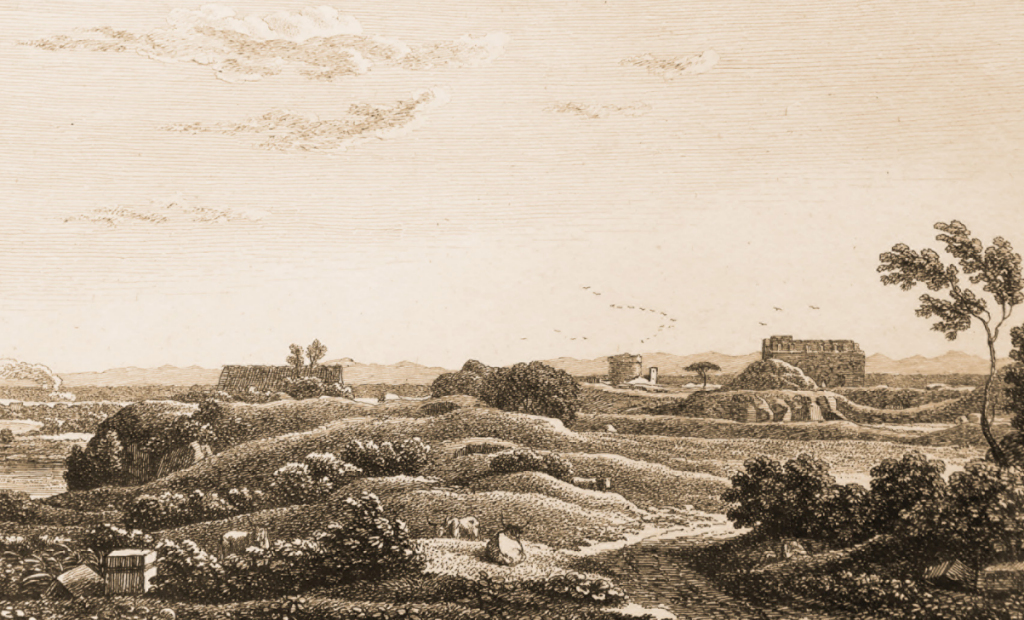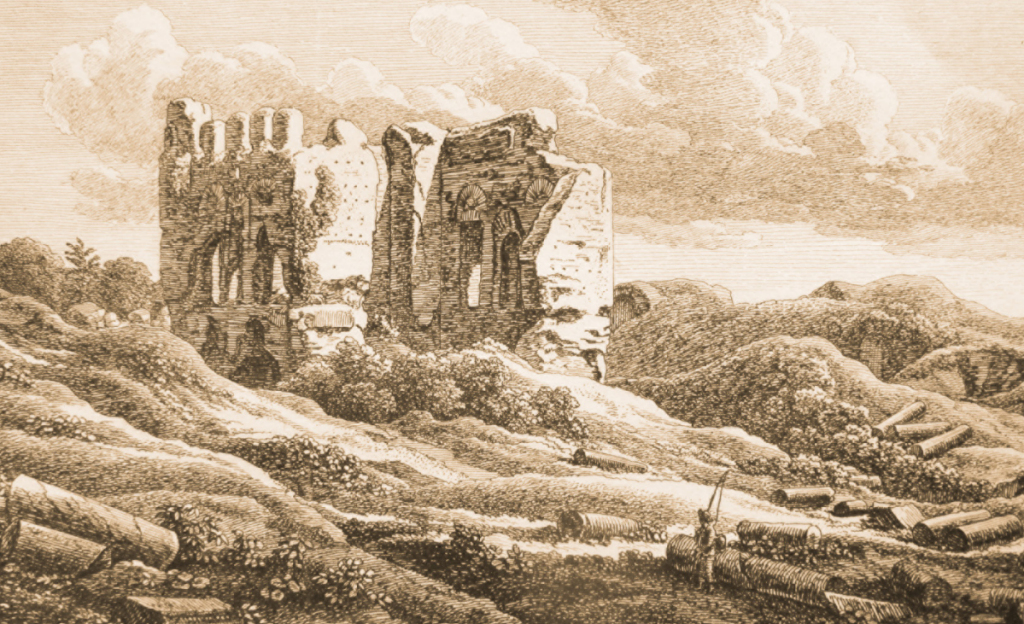FROM THE 12th TO THE 16th CENTURY
In 1162 AD Waltherus, a cleric from the diocese of Arras in France, visited the medieval village. Waltherus was a Canon Regular, living according to the rules proposed by Saint Augustine. In Ostia he hoped to find relics of the mother of Augustine, Monica, who had died there in 387 AD. Clergymen in the village told him that the remains of saints in the deserted village were numerous, and led him to a tomb in the Porta Romana necropolis, where he excavated some bones, which he took with him back to France. This was certainly not the tomb of Monica: her funerary inscription was found near the church of Saint Aurea in the borgo (another discovery of her remains, in 1430, under the high altar of the church, is equally suspect). The clergymen also mentioned people walking to the "church of Saint Cyriacus outside the medieval village", to hold mass. This tiny church has been excavated, and can still be seen next to the theatre: the Christian Oratory (II,VII,1). The people who went there must have followed the old Via Ostiensis and Decumanus Maximus, now flanked by collapsed and partly overgrown buildings.
A second glimpse of the ruins of Ostia in the early second millennium dates back to 1190 AD. In that year a ship carrying Richard Coeur de Lion (the Lionheart), on his way to take part in the First Crusade, docked at the mouth of the Tiber. He passed a place called "Le Far de Rume", obviously receiving its name from the remains of the lighthouse of Portus. He saw "immense ruins of ancient walls and a very beautiful, solitary tower", most likely the remains of Portus and the lighthouse. Richard met the bishop of Ostia, but did not go to Rome to visit the pope. Continuing to Anzio-Nettuno and Naples he sailed past a forest called Selvedeme, which is probably a corruption of 'Selva d'Enea', the forest of Aeneas. It is a reference to the mythical nature of the area to the south of Ostia, where according to tradition Aeneas set foot on Italian soil. Richard heard that the road along the coast was paved with marble, and that the forest was full of deer, goats, and gazelles.
A document from 1191 AD, issued by pope Celestinus III, mentions a spot in Ostia called Calcaria: properties are listed "outside the gate of that city [Gregoriopolis], not far from the same city Ostia, located in a place called Calcaria" (extra portam eiusdem civitatis, non longe ab eadem Hostiensi civitate, sita in loco qui vocatur Calcaria). This is a reference to a lime kiln, in which ancient marble was burned for mortar.

Ostia seen from the west, in 1810 (J.C. Reinhart). The ruins will have looked much the same in earlier centuries.
In 1420 pope Martinus V reinforced Tor Boacciana, a tower at the mouth of the Tiber, using ancient building material, including marble. In 1427 Cosimo de' Medici (a famous banker and patron of the arts from Florence) and Poggio Bracciolini (known especially for his discovery of ancient Latin manuscripts) visited Ostia in the hope of finding inscriptions. They had no succes and again we hear about lime kilns, near the Capitolium: "When we went to see the harbour, Cosmus and I found no inscriptions at all; for that temple, which they demolish for lime, is without inscriptions", wrote Poggio Bracciolini (Cum ivimus ad videndum portum, Cosmus et ego nulla invenimus epigrammata; nam templum illud, quod isti pro calce demoliuntur, est sine epigrammate). In 1437 Niccolò Nicoli, in Florence, was the owner of a "jasper intaglio with Narcissus, looking at himself in the water, found in Ostia, while they were excavating".
In Portus, somewhere between 1439 and 1472, cardinal Bessarion found a statue of Liber Pater and an inscribed base with a dedication to Liber Pater Thyoneus. The base had been set up by the corpus lenunculariorum Portuensium, "the guild of the operators of the small boats in Portus", but it may be a forgery. In spite of being a humanist, the cardinal had the statue thrown into the sea, because it was profane. It must still be lying somewhere under the Tiber silt.
In 1463 pope Pius II (Aeneas Silvius Piccolomini, a humanist like cardinal Bessarion) visited Ostia and Portus. He went there by boat. On the banks of the Tiber he noted "traces of ancient ruins, which in many places hem in the river-bed like walls". In Ostia he saw ruined porticoes, prostrate columns, fragments of statues, the walls of an ancient temple stripped of its marble (surely the Capitolium), and part of an aqueduct. The pope and his company tried to find out the precise location of an Imperial palace. On the Isola Sacra they saw the marble yard of Portus. In Portus itself they saw traces of the lighthouse, far out in the sea, and the ruins of a city gate, city walls, temples and churches. Around Trajan's hexagon mooring stones had been preserved, warehouses and shipsheds. In spite of an earlier prohibition, the pope was also looking for marble from Ostia and Portus for the construction of Saint Peter's. In 1463-1464 the search lasted six months and paid well. Another prohibition was sent to Ostia in 1471, forbidding the extraction of marble in whatever form. In 1488 a search for antiquities was going on in Ostia on behalf of Lorenzo de' Medici.

The Capitolium seen in 1810. The ruins have always been visible.
Image: Gallico-Turco 2020, fig. 7.
In 1483 the present castle of Gregoriopolis ("Rocca") was built by cardinal Giuliano della Rovere. It had to protect Rome from incursions by raiders. Of course ancient building material was used. In the late fifteenth century the church of Sant'Aurea was rebuilt by Baccio Pontelli. In the second half of the sixteenth century a building used in the production of salt, the Casone del Sale, was built amongst the ruins of Ostia (much later the museum was installed in this building). The salt pans of Ostia were used as late as the second half of the nineteenth century.
In the 16th century many fake inscriptions were made by Pirro Ligorio. In the Corpus Inscriptionum Latinarum 69 are described, mostly found in Portus. Ligorio was also one of the first to make a reconstruction drawing of Portus, published in 1554. A whole series of plans and reconstructions would follow. Of exceptional importance are two frescos made in 1582 by Ignazio Danti, now in the "Galleria delle carte geografiche" of the Vatican Museums: one shows the remains that could be seen, the other his reconstruction (they can be found in the section Maps, plans, bird's eye views).
The medieval fortress lost its function in 1557, due to a major inundation. On September 15 the meandering Tiber changed its course. The branch of the Tiber along the castle was cut off, so that the fortress became useless. The old branch was gradually filled with earth and is today known as Fiume Morto ("Dead River"). The inundation of 1557 also destroyed a large stretch of the ancient Tiber quays.
Throughout the 16th century objects were dug up in Ostia and Portus. For example, in 1547 and 1553 marble was extracted for the Palazzo Farnese and Villa Giulia. In 1588 a large block of marble from the harbours was used as the base of the statue of Saint Peter on top of Trajan's Column. In the preceding centuries Ostian marble - including inscriptions and sarcophagi - had been reused in the cathedrals of Pisa, Florence, Orvieto and Amalfi, after raids. In 1598 pope Clemens VIII gave permission to search the ruins of Ostia and Portus for marble, again to be used in Saint Peter's (Lapides antiquos et marmoreas extrahi faciendi quotquot haberi poterunt ex Portuensi et Hostiensi civitatibus, eorumque portubus, et agris absque licentia). The forests to the south of Ostia were searched as well.